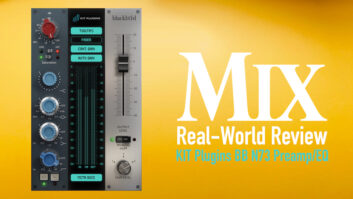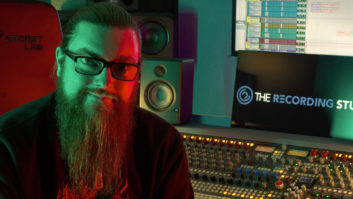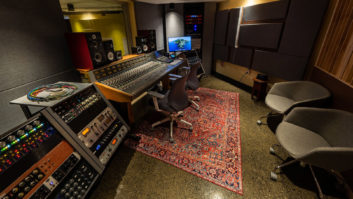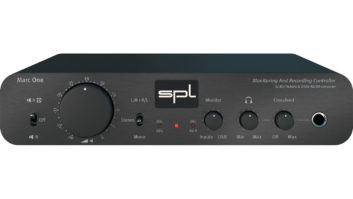Listen to a TV program from the next room and you can still understand most of what goes on. Watch the pictures with the sound off and you’ll miss a great deal, not only in terms of plot and dialog, but also in the excitement and feel of the show. Anyone who works in audio post knows this very well. But for the companies that make professional and prosumer digital media tools, there has been a firm dividing line between companies that make nonlinear video tools and those that make serious digital audio workstations. That is now changing in a big way, with four major companies in the video software space having acquired audio companies or software in the past 15 months. To understand the dynamics behind the shift, Mix spoke to some of the major players now engaged in working in both sides of the post-production media fence: Apple, Pinnacle, Adobe and Sony Pictures Digital.
The precedent for all of this was set in 1995 when Avid Technology acquired Digidesign, looking to provide a credible audio engine and professional-quality audio I/O for its flagship Media Composer video editor product line. Having won the top spot in the emerging digital video nonlinear editing (NLE) market in the early ’90s, Avid was the first to see the big picture and realize that the entire ecosystem of film and video production would eventually go digital.
As the DV and DVD revolutions took hold in the ’90s, it also became clear that the digital media-tools market would cover the entire spectrum, from high-end Hollywood to the emerging prosumer and home-video enthusiast. Several companies rushed to fill in these down-market niches, focusing first on providing video products, but realizing that, eventually, a suite of applications that covered all of the bases (graphics, titles, DVD, audio) would provide the most compelling offering.
This tactic of providing a single source for specialized video and audio tools capable of working together proved very successful indeed for Avid, so it’s not surprising that other players in the video NLE market would eventually follow suit. In fact, what is perhaps most surprising is that it took so long. But now, the strategy seems to have caught on, and at least four other large media companies can boast a growing suite of media tools that includes at least one serious audio application. And there may be more to come. The market impact of these mergers and acquisitions remains to be seen, but it’s clear that it promises to forever change the business and creative landscape of audio post-production tools.
APPLE AND EMAGIC
Apple Computer Inc. acquired a never-released video product, called Key Grip, from Macromedia in 1998 and released it in April of 1999 as Version 1.0 of Final Cut Pro. In the more than four years since, the Final Cut Pro nonlinear video editor has gone on to claim a respected position in the market for video NLE systems. Following that same acquire-and-develop strategy, Apple acquired DVD companies Astarte in 2000 and Spruce Technologies in 2001 to provide the basis for its iDVD and DVD Studio Pro products. In February 2002, Apple purchased the software company Nothing Real and its Shake and Tremor video-compositing applications.
It’s not surprising that Apple would understand the need for a world-class audio solution to augment its already considerable video media applications portfolio. Thus, in July of 2002, Apple acquired Emagic Soft and Hardware GmbH, a leading audio software company based in Hamburg, Germany. Apple has maintained the Emagic brand names and is operating Emagic as a subsidiary with its own marketing identity, a very reassuring move for Emagic’s considerable user base. Although Apple now features the Logic Platinum 6 application on the Apple Website (www.apple.com/software/pro/logic), Emagic still maintains its own identity and Web presence atwww.emagic.de.
One of the first things Apple did was announce that it was dropping support for the Windows version of Emagic’s flagship product, Logic Platinum, a move that certainly disappointed PC users. But it is clear that Apple views its strong stable of media applications as a means to garner market share for the Macintosh platform, so it was not a completely unexpected strategic move.

As we’ll see with all of these companies, the underlying technology of the acquired audio systems is expected to help add onto audio capabilities of existing video products and to help create new products.
Apple’s Soundtrack application is a case in point. First announced at NAB 2003 as an add-on for Final Cut Pro 4, it has now been released as a stand-alone, loop-based audio application. In the tradition of loop-based software such as ACID, Apple’s Soundtrack is designed to allow nonmusicians to quickly and easily assemble soundtracks using premade loops of sound.
According to Xander Soren, senior product marketing manager for audio in the applications group at Apple, Soundtrack began as a tool within Final Cut Pro 4 that allowed video users an easy and relatively inexpensive solution to quickly create background music tracks for their videos. He says, “We’ve found that as technology enables people to do more, they naturally want to take on more. Previously, video editors would deal with the visual aspect of their video, and then they’d have to handle the audio and music creation separately in a very specialized way. Often, that workflow was very time-consuming. In developing Final Cut Pro 4, one of the things we really focused on was expanding the audio functionality to allow video editors and producers to participate more actively in the music composition and audio production process. Final Cut Pro 4 introduces a completely new audio mixing architecture and includes Soundtrack, a companion application for creating music directly against a video piece. We’re seeing video editors use Soundtrack to prototype their audio score before handing it off for composing, but we’re also seeing video editors developing their own complete music compositions entirely on their own. Soundtrack is going to introduce a large number of video professionals to the world of audio production, and it is an important part of a larger workflow that includes Emagic’s Logic.”
The result is a loop-based music-creation product that ships with an impressive 4,000 loops. As an example of the cross-fertilization of Emagic audio technology into Apple products, Soundtrack includes over 30 professional effects plug-ins, some that Apple has developed especially for the product and some that come straight from Logic Platinum. The Logic effects even provide Soundtrack users with a taste of the Logic interface within the context of Soundtrack.
Although the idea originally was to provide the Soundtrack application within Final Cut Pro 4, the product’s enthusiastic reception has broadened that original target market. Soren says, “When we saw the reaction of creative users to the Soundtrack product at NAB, we realized the product was attractive to a larger market than video editors…the market interest was great enough that we have now released Soundtrack as a stand-alone application for $299.”
As for file and project-level interchange and compatibility, Soundtrack supports .AIFF, .WAV and ACID loop formats, as well as the new Apple loops format and QuickTime. Soundtrack also allows for rendering any of the individual tracks as an .AIFF file so that it can be brought to other applications. Project-level interchange such as OMF or AES31 is not directly supported in Soundtrack; instead, Apple has made an XML interface available for Final Cut Pro 4 so that qualified developers can create bridges between the system and interchange formats such as OMF and AAF. Apple never directly addresses future or unreleased products, but it is clear that pro audio is now a serious market for the company. The products released so far are just the first wave.
PINNACLE AND STEINBERG
As one of the early forces in digital video for the broader consumer and prosumer markets, Pinnacle has been creating video applications since the early ’90s. The company acquired FAST Multimedia in September 2001, and added the Liquid line of professional editing systems to the Pinnacle roster as a result. Pinnacle also acquired Commotion, a video effects and compositing application in 2000. The need to develop a complete suite of media-production tools brought Pinnacle to German pro audio company Steinberg Media Technologies GmbH. In January 2003, Pinnacle acquired Steinberg as a wholly owned subsidiary.
Bill Loesch, Pinnacle’s VP of engineering and product management, explains that Pinnacle did not just acquire audio technology for the sake of its video products: It sees the acquisition of Steinberg as putting the company clearly in the audio market. Speaking about the approach Pinnacle is taking compared to the other companies mentioned here, Loesch says, “We all come at it from a similar point of view: Audio is part of video. You can decide you’re going to develop that technology and put it in your video editor, but the trouble with that is that it’s not very efficient. You don’t get to amortize the development cost of that audio technology over as wide a market as possible. So from a business point of view, Avid led the way, but everybody else has concluded the same thing: You’re better off amortizing that development cost by being in the audio market, as well as using the technology in your video products.
“We’ve set Steinberg up as a separate division and maintained the management structure and people,” he continues. “What we’re working on is gaining synergies from being in both the audio and video businesses. We’re providing technology to the Steinberg team to help them integrate video into their application, and they’re providing technology to our edition team and our studio team to integrate better audio into those apps.”
Pinnacle sees its market as slightly downscale from the major Hollywood feature space where Avid and Digidesign predominate. This means that the average sales price for systems is lower, but the volumes are a lot higher, just as with Steinberg. Another reason that Steinberg was attractive to Pinnacle was its shared philosophy: They both depend on native processing rather than specialized, external hardware DSP. There is a clear understanding that Steinberg knows the market for its products very well, and Pinnacle respects that and supports it. As Loesch explains, “We don’t have any plans to do anything different with what Steinberg does; we acquired Steinberg because it’s a leading company in its category.”
As for file interchange, Steinberg’s Nuendo system does provide OMF support, but Pinnacle’s video products don’t share that capability at this time. According to Loesch, “We don’t currently support project-level interchange such as OMF/AAF in the Pinnacle products. We are looking at that, but we haven’t decided whether it will be incorporated in the next version.”
ADOBE AND SYNTRILLIUM
One of the earliest digital video software applications on the market was Adobe Premiere®, now called Premiere Pro. Since its inception in 1991 as a QuickTime editor, Premiere has brought the price point of digital video-editing tools within reach of many media-savvy consumers and corporate A/V departments. Adobe followed with other video tools, such as the well-respected After-Effects® (1994) and more recently with the DVD authoring application, Adobe Encore™ DVD (March 2003). With a growing roster of media applications, the need for a professional tool to deal with audio resulted in the announcement in May 2003 that Adobe was acquiring the software assets of Syntrillium software. The company’s flagship audio product, Cool Edit Pro, has now joined the lineup of Adobe media applications as Adobe Audition.

Dave Trescot, senior director for Adobe Digital Media, says, “We saw this product as the ‘Adobe Photoshop’ for audio. There are two main reasons for our expansion into audio. First, Adobe has always been driven to provide the high-quality tools that creative professionals use in their daily work. Clearly, audio professionals [especially musicians and broadcasters] were one creative group that Adobe did not address. The acquisition of Cool Edit Pro gives us a great product to offer to them. Second, the audio product completes our digital video workflow offering, including video editing with Premiere Pro, motion graphics with After Effects, DVD burning with Encore DVD and audio production with Audition.”
Unlike Apple and Pinnacle, Adobe acquired only product assets and personnel, not the corporate identity of the other company. As Hart Shafer, product manager for Adobe Audition, says, “Adobe acquired all assets of Syntrillium, including Cool Edit 2000, Red Rover and shareware. Syntrillium is continuing to sell its entire product line until the release of Audition in order to ensure continuous availability of Cool Edit Pro/Adobe Audition. However, once Audition is released [scheduled for August 25], the whole Syntrillium product line will be discontinued, and only Cool Edit Pro will live on as Adobe Audition.” Trescot adds, “All of the engineering, quality-assurance, designers and product-management teams have come over to Adobe as employees.”
Adobe clearly sees Audition as more than just a product for video specialists, and is intent on supporting the product within the pro audio community. Trescot points to some of the software’s unique strengths: “In the audio-only space, Audition is the only package that integrates a wave editor, multitrack recording and editing, and loop-based song creation in a single application. Not only does that make it a bargain since you don’t have to buy multiple pieces of software, but it greatly improves workflow since you don’t have to save your audio to send it back and forth into each application. In addition, Audition is 32-bit throughout all processing, comes with more than 45 high-quality DSP effects, supports dozens of file formats, can be scripted, runs batch processing and much more. Audition is a toolbox that offers something for every audio professional.”
The audio technology that Adobe has acquired is bound to enhance the audio capabilities of other Adobe products over time. Trescot says, “One of Adobe’s strategic plans is to share its core technologies between applications. This can be seen in other areas within Adobe, such as Adobe PDF, imaging, vector graphics, fonts, etc. Audio is a core technology that will move to other products as appropriate.”
According to Trescot, although Adobe Audition does not currently support OMF or AES31 project interchange, Adobe recognizes the importance of file compatibility, interchange standards and project workflow. He explains, “Audition does not currently support these cross-product project file formats. Adobe is, however, committed to cross-product formats. As an example, Adobe has recently joined the board of directors for the AAF association in order to help promote that standard.”
SONY SCREENBLAST AND SONIC FOUNDRY
On July 31, 2003, Sony Pictures Digital completed the acquisition of the desktop software assets of Sonic Foundry. Unique among the companies mentioned in this article, the Sony Screenblast business model provides media tools, but also leverages the company’s media assets through a significant Web-based component. In effect, the Screenblast project acts as a bridge to connect Sony’s consumer electronics business (digital video, audio and computers) and its film and music content groups. The idea is to encourage owners of camcorders, PCs and other devices to interact with content — both their own and Sony’s — using the Screenblast media creation and editing tools in combination with the Screenblast Web service. The Screenblast applications provide video and audio editing capabilities, while the Screenblast.com service provides subscription-based content (video, music loops, sound FX, graphics), software tips, interviews with important film and music producers, training, project templates and a user’s gallery that allows subscribers to post their own digital creations for all the world to see.
When Screenblast was created, the company entered into a licensing arrangement with Sonic Foundry of Madison, Wisc., to create custom-branded versions of its ACID loop-based audio software and Vegas video-editing application. Sony acquired Sonic Foundry’s software group with the idea to start with the original Sonic Foundry apps, modify the feature sets to orient them to the consumer market, add a layer of integrated tutorials and tie the apps directly into the Screenblast.com media services. The result of this collaboration was first released in 2001 as Screenblast Music Studio and Screenblast Movie Studio.
Even before its acquisition, it was no secret that Sonic Foundry’s fortunes had declined precipitously. The heady days of the Internet bubble had ended; gone were the days when the company had a market cap of over a billion dollars. With Sony in need of proven A/V software technology and Sonic Foundry in need of cash, the agreement made a great deal of sense for both parties. The deal, worth some $19 million in cash, brought Sound Forge, ACID, Vegas Video and Vegas+DVD to Sony and left Sonic Foundry with its live and on-demand Web presentation product, Mediasite Live™.
Mix spoke with Don Levy, senior VP of marketing communications at Sony Pictures Digital, and Ian McCarthy, director of Screenblast product development. Levy says, “We became familiar with both the products and the team behind them over the course of our three-year association on our Screenblast personal media software and service. The opportunity fit in well with both companies’ business interests.”
Sony plans to keep the development team together in Wisconsin and has already announced plans to hire 12 new software engineers, an increase of 20% in staff. Sonic Foundry will continue to operate its media tools business, focusing on the MediaSite Live application with a team of about 30 people. Although to date, the Screenblast service has been focused on the broader consumer market rather than audio/video professionals, the acquisition of the full range of Sonic Foundry applications will allow the company to move into the higher-end prosumer and professional markets.
Addressing the possible concern that Sony might only maintain the consumer version of the software, Levy says, “We are supporting and continuing development on all of the existing desktop software products. With regard to the ACID product, with over a million applications already in the market, it has become something of an industry standard and a consumer favorite for creating songs and music albums, remixing loops and scoring videos. The Vegas video line’s robust features, combined with an intuitive interface, delivers exceptional value to the high-end user.”
As for project-level interchange and workflow considerations, Sony has already gone to great pains to provide OMF compatibility in the Xpri, the high-end video-editing system from Sony Electronics. The Screenblast apps currently provide direct import and export of a wide range of audio and video file-types, including the three principal streaming media formats: Windows Media 9, Real and QuickTime. As for project-level interchange and interchange standards, McCarthy says, “Supporting industry standards and enabling both project and file interchange are very important objectives to us as we move forward.”
WHO ELSE WANTS TO PLAY?
There are still some notable players in the digital video market such as Ulead Systems (www.ulead.com), Roxio (www.roxio.com) and others that don’t offer specialized digital audio applications to support their video, DVD and graphics effects products. They could, of course, write their own from scratch, but given the long development times required to build a robust and full-featured audio application, it wouldn’t be surprising if the acquisitions were not quite over yet. The consolidation and attrition in the digital audio workstation market during the past few years may provide one of the best avenues for some of the remaining players to secure a profitable future. Certainly, it puts the phrase “audio follows video” in a whole new light.
Ron Franklin is a frequent contributor to Mix.







